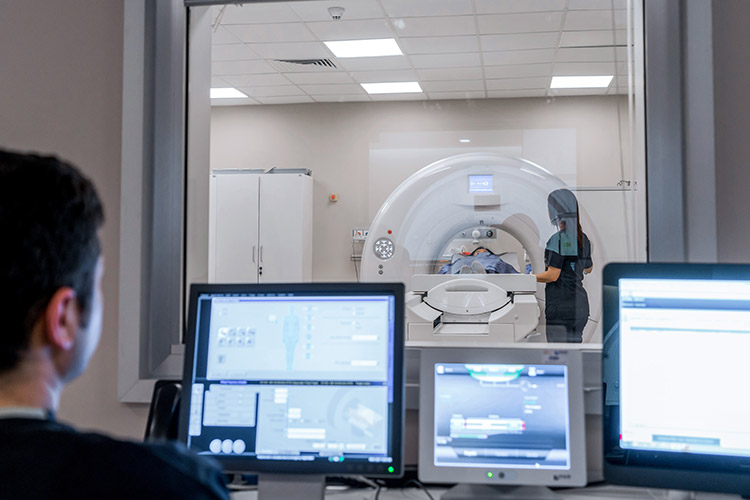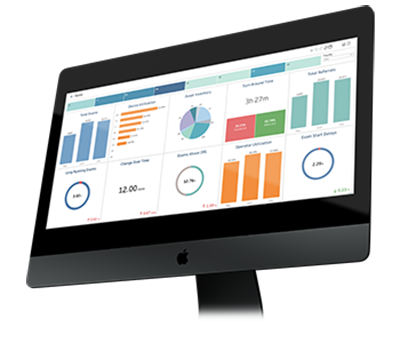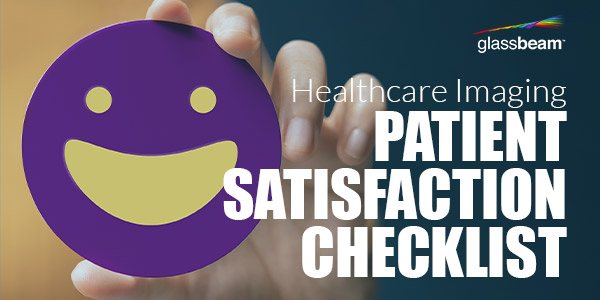
Driving Standardization and Excellence Across the Imaging Organization
Healthcare systems and their imaging departments are constantly challenged to reduce costs while providing excellent patient care. Imaging providers that prioritize operational excellence and standardization can identify and eliminate unnecessary expenditures such as supplies, medical equipment, time, and personnel. This can help imaging departments cut costs and operate more efficiently. When imaging departments are more efficient, their staff can focus on patient care, resulting in increased patient and staff satisfaction.
One of the most effective ways to eliminate unnecessary resources and improve workforce efficiency in the imaging department is through standardization. Standardization can reduce costs by eliminating unnecessary variations in procedures and lessen the need for duplicate medical equipment or supplies. Standardization ensures that all imaging procedures are performed in a consistent manner, regardless of the facility, location, or personnel involved. This leads to more accurate and reliable results, and helps imaging departments reduce errors, ensure quality and compliance, increase efficiency, and reduce costs.
Healthcare systems that focus on standardization set themselves up for operational excellence and give their organization a stronger competitive edge.
Secure Organizational Alignment
One of the biggest challenges imaging leaders face is effectively communicating the organization’s strategy and performance goals to all members of the imaging department, from the top-level leaders to the front-line staff. Imaging leaders need to ensure that everyone understands the goals and how they contribute towards achieving them.
While the strategy comes from leadership, it should be modeled by everyone throughout the imaging organization. This helps employees understand what the organization values and expects.
To help get alignment, imaging department leaders must ensure individual performance goals clearly connect with the overall departmental goals so that everyone is working towards the same objectives. Some staff members may resist changes to their roles or processes, particularly if they do not understand the rationale behind the changes. Therefore, imaging leaders need to communicate the benefits of the changes and provide support and training to help staff members adapt.
Imaging leaders also need to establish clear metrics and key performance indicators (KPIs) to measure progress towards the performance goals. Communicating the metrics, KPIs, and expectations will all help drive alignment. Imaging leaders must be proactive in addressing these challenges to ensure that performance goals are effectively cascaded throughout the department and that progress towards these goals is tracked and measured.
Standardize Medical Imaging Devices and Technologies
Imaging departments have found that standardizing on their medical imaging systems increases staff productivity. Rad techs typically move between different medical imaging devices within an imaging department and their workload can be spread across one facility or several. Having consistent medical imaging devices, interfaces, procedures, and protocols across the imaging department can all help techs be more efficient with their time.

A well-functioning, productive imaging department enables its clinicians, imaging technicians, and other staff to work more efficiently with the assistance of technology. Standardizing on technologies in the imaging department improves workforce productivity, which leads to greater employee job satisfaction and retention. Implementing technology solutions such as PACS, RIS, and artificial intelligence can help imaging departments improve their speed, accuracy, and quality of diagnoses. It can also reduce human error and improve patient outcomes.
Establish Effective Communication Processes
Imaging departments need to collaborate with other departments to ensure that the right tests are ordered, and the right results are communicated to the right people. Standardizing on a communication process between departments can not only improve communication, but it can reduce errors and improve patient outcomes. Implementing standard data formats, such as DICOM, ensures that images can be easily shared and accessed by healthcare professionals.
Establishing standard reporting templates also improves communications. Standardization of reporting templates ensures that reports are consistent and easy to interpret by healthcare professionals. To do this, imaging departments can develop standard templates for imaging reports that include information such as the indication for the exam, the imaging findings, and the impression.
Having a consistent patient communications processes is also an important factor in establishing operational excellence. A standard survey with the goal to understand more about the patient’s experiences with an imaging department can help identify disruptors in workflow and patient care.
Standardizing effective staff communications is also necessary. Imaging leaders should keep the imaging department’s staff informed about updates and changes to the schedule, protocols, or processes. Managers and leaders who are receptive to feedback and encourage open communication, find their workforce is more engaged.
Regular team huddles are a great way to reinforce goals, discuss cases coming up, review who’s covering which machines, and what the volume looks like. Imaging leaders find the workforce is focused on what they need to accomplish that day and the goals they’re working toward.
Establish Quality Assurance and Compliance Programs
Standardization of quality assurance programs is essential to ensure that the imaging equipment is maintained and calibrated to the highest standards. This can be achieved by implementing regular quality control procedures, such as daily checks of imaging equipment, regular calibration, and maintenance schedules.
Imaging departments must maintain high standards of quality to ensure that accurate diagnoses are made. Operational excellence can help ensure that quality standards are met consistently. Standardization helps maintain high standards of quality in imaging procedures. By ensuring that all procedures are performed in the same way, imaging departments can minimize errors and improve patient outcomes.
Standardizing image analysis techniques in an imaging department is essential to ensure that images are analyzed consistently and accurately. This can be achieved by using standardized techniques for image segmentation, feature extraction, and classification.
Imaging departments must comply with various regulations and standards, such as HIPAA and accreditation requirements. Operational excellence can help ensure that these requirements are met consistently. Standardization helps imaging departments comply with regulations and accreditation requirements. By following established standards and guidelines, imaging departments can ensure that they meet all regulatory requirements and maintain their accreditation status.
Measure Asset Utilization
Proper utilization of medical imaging devices in an imaging department is key to maximizing productivity and achieving operational excellence. Maximum uptime, lean clinical workflows, and efficient patient scheduling are all essential to optimizing asset utilization. Any scheduling issues or extended downtime can result in idle machines, negatively impacting staff productivity, patient care, and department revenues.
Standardizing on technologies in the imaging department improves workforce productivity, which leads to greater employee job satisfaction and retention. A key performance indicator, asset utilization, is a good measure of productivity in an imaging department. The higher the utilization, the more productive the imaging department is.
Advanced utilization analytics can provide valuable insights by drawing on multiple data sources. The result is greater visibility into patient throughput, device utilization, and staff performance versus operational targets. For Example, analytics can reveal patient exam turnaround times for an individual medical imaging device or the number of exams performed during a specific time against benchmarks or peers.

Utilization data analytics can help pinpoint scheduling and workflow issues by identifying patterns across individual and multiple medical imaging devices and sites. Using real-time utilization data can increase device throughput, ensure timely patient exams, and boost revenue while still controlling costs.
Define Standard Imaging-Specific KPIs
Imaging leaders need to establish clear metrics and imaging-specific KPIs to measure progress against performance goals. It is important for imaging departments to work with their organization’s leaders to define and standardize on the KPIs.
Data analytics can paint a powerful picture of how different care sites are performing compared to one another. Cascading a common set of KPIs across a system can help leadership make strategic, data-driven decisions around staffing, training, and technology to increase productivity in the imaging department.
Continuously monitoring KPIs that impact efficiency allows imaging departments to make informed decisions, using the most current data, on staffing and resources. These metrics will also help an imaging provider identify root causes to issues and opportunities for improvement.
Monitoring metrics such as exam volume, changeover time, report turn around, and referral patterns can offer insights into growth, best practices, and areas for improvement. These metrics also provide continuous guidance on appropriate staffing and hours of operation.
Exam start delays, repeat scan rates, and tech productivity are good KPIs to track when evaluating staff productivity and competence. These metrics help leaders evaluate if the operators are meeting the imaging department’s established benchmarks and identify areas for improvement and opportunities for additional training.
By tracking and analyzing these metrics, imaging departments can increase the performance of their staff, improve patient satisfaction and operational excellence.
Invest in Predictive Analytics
Many imaging organizations continue to rely purely on historical data to solve challenges, which keeps them in a reactive position and leads to a continuous loop of stagnation and wasted resources. However, imaging organizations that leverage artificial intelligence and machine learning are getting prescriptive, actionable solutions.
Predictive service analytics can reduce the frequency and length of unplanned downtime, enabling imaging departments to reduce costs and workflow disruption, while also improving their operational efficiency. Predictive analytics can also help imaging departments optimize their workflows and resource allocation, reducing wait times, decreasing the number of unnecessary tests, and improving overall efficiency. Imaging departments can use these analytics to manage their resources more effectively, ensuring that equipment and staff are available when and where they are needed.
Focus on Patient Satisfaction
Imaging organizations that are working toward operational excellence need to make sure their strategy clearly defines what patient experience and patient satisfaction look like. Operational excellence can help ensure that patients receive accurate and timely diagnoses, leading to better outcomes and patient satisfaction. Imaging departments should also focus on providing a positive patient experience by reducing wait times, providing clear instructions, and ensuring patient comfort.
Mapping the patient journey throughout the imaging department can be a useful tool to help leaders identify where disruptors are. The journey should involve as many employees as possible who provide care in that department. Mapping the patient journey helps the imaging department identify disruptors to a patient’s experience and identifies opportunities for standardization to streamline the patient’s journey in the imaging department. For Example, if a rad tech doesn’t explain the steps of an MRI scan to a patient, the patient can panic from the unknown and become claustrophobic. The rad tech would have to stop the exam and pull the patient out of the gantry. If the department had standardized a patient communication process for exams, this disruption to the exam may be potentially avoided.
Surveying patients and gathering feedback about their experience at the facility and with staff can also help identify disruptors. Surveys can provide immediate feedback to the imaging staff about their processes and what needs to be changed.
Utilize the PATIENT SATISFACTION CHECKLIST to ensure your imaging department is implementing modern best practices.
Establish a Positive and Consistent Culture
In today’s environment of staff shortages and high burnout rates, it’s even more important for healthcare imaging providers to establish a positive work culture among employees to increase motivation, foster teamwork, and create a sense of ownership. Having a defined and consistent culture that all imaging employees can align to will help drive operational excellence.
Standardizing on a reward and recognition system is critical to retain employees. When imaging techs are recognized and rewarded for their productivity, they are more likely to continue being productive. While monetary rewards such as raises and promotions are important, other recognition and rewards can be very effective. Something as simple as providing positive feedback or recognizing an employee at a staff meeting can really make an impact. These actions require no money, only a little bit of time, and can go a long way in encouraging staff to be productive.
Using consistent visual management tools can help imaging departments gain employee alignment to the organization’s priorities, expectations, and goals. Standardized visual management tools, such as posters that display the department’s goals, is an easy way for team members to stay focused on their performance goals. These tools reinforce the metrics that impact the direct team and they can see how they’re performing against their goals. A visual dashboard in the department that displays system performance trends aligns the staff with what is important for success. These goals can include technologist productivity, number of patients scanned in a day, adverse events such as patient falls, satisfaction survey results, or system uptime performance. Involving all team members in contributing to the results, and sharing progress along the way builds in accountability, teamwork, and improved performance.
Invest in Career Development
In a career where understaffing and burnout are common, it’s important to make sure employees see a career path and not a dead end. Working with staff to develop individual career development plans is one way to address this. Creating a standardized career development process will help employees feel they have a career path and a direction within the organization.
Cross training is one option imaging employees can use to expand their skillset and explore other areas of the organization. Standardizing on a cross-training process not only provides new opportunities for a tech, but can help with staffing challenges as well. An employee who’s dual or triple credentialed provides the imaging department with flexibility to move that person to different imaging devices when needed.
Allowing staff to take on responsibilities such as managing new team members, leading a new project or initiative, or representing the team on an internal committee, can build their leadership skills and provide exposure to different parts of the organization. Providing staff with opportunities to have a mentor and sponsors within the department will make them feel valued and supports their career development plans. In addition, providing tenured staff the opportunity to be a mentor, supports the career development plans for those who are interested in leading a team.
Achieve Tangible Results
Standardization is critical to achieve operational excellence in an imaging department. It ensures consistency, quality, efficiency, compliance, and reduced costs. Ultimately, this leads to better patient ratings, which directly impacts the finances of the department.
According to a study by Deloitte Center for Health Solutions, hospitals with better patient ratings earn disproportionately more revenue per patient day than those with low ratings. A Harvard Business Review article cited that a five-point increase in a hospital HCAHPS (Hospital Consumer Assessment of Healthcare Providers and Systems) rating is associated with a one percent increase in profit margin. Better employee engagement correlates with better outcomes, connecting the dots between business performance and improvement in the perceptions and experiences of both patients and caregivers.
Imaging departments that pursue operational excellence are setting their organization up for success and will have a competitive advantage in the market. As a result, those imaging organizations can differentiate themselves from their competitors, attract more patients, increase revenue, and establish a positive perception in their community.
Explore the Possibilities
With more than 1 million exams examined each day by Glassbeam solutions, see how top organizations are transforming their log data into impactful insights.
Transform Your Healthcare Operations
See how to gain deeper, clearer insight from your machine data to elevate business intelligence and to improve your operational uptime, utilization, and efficiency.
